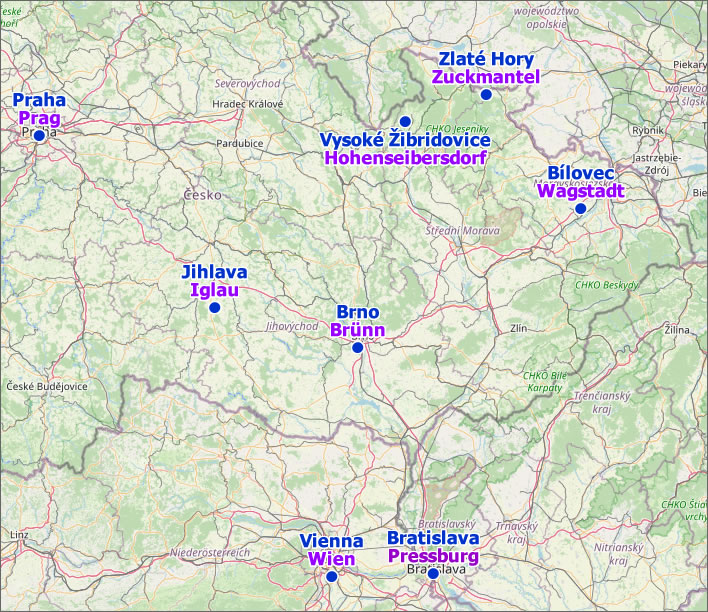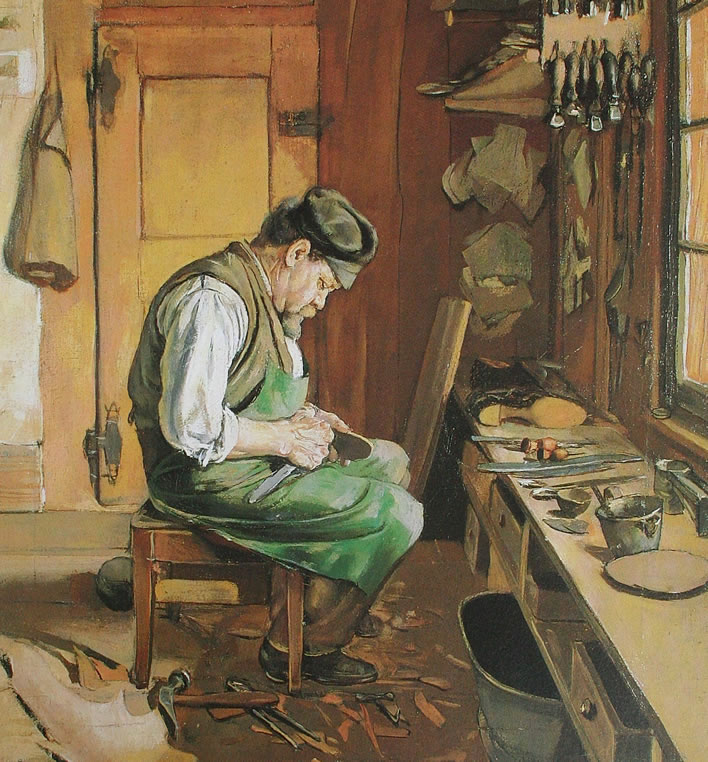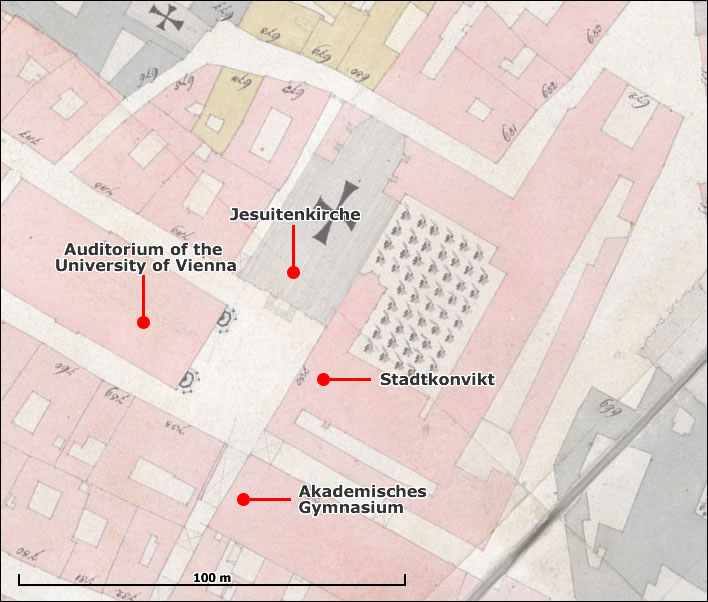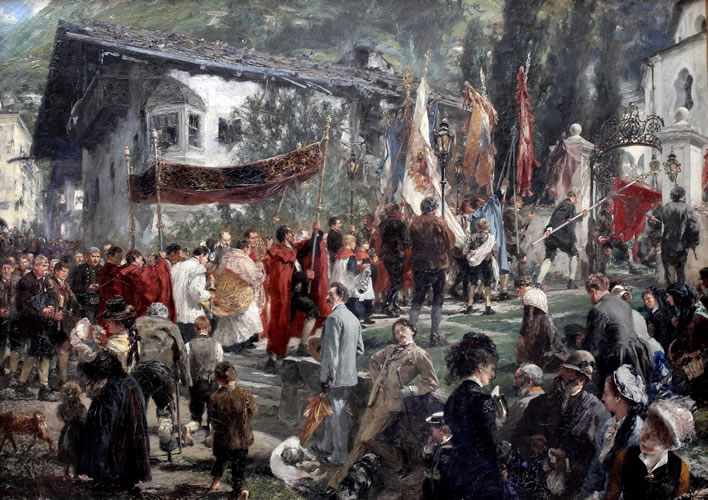Ignaz and Elisabeth Wagner
Posted by Richard on UTC 2020-07-08 14:24
The Schubert community
So far we have portrayed Franz Theodor and Elisabeth Schubert's family as an almost free-standing entity, except for its obvious links to his brother Karl and Magdalena's family in the Leopoldstadt school.
It requires no more than a moment's reflection to realise that this portrait is inherently defective. It must be.
Franz Theodor was a respected figure in his community, known not just by those who had children. The many local children who passed through his school knew him well and retained that knowledge into adulthood. The Catholic church had a controlling interest in the school, meaning that he would be a well-known figure in the religious hierarchy of the community.
He may not have spent his evenings in the tavern but he was no sociopath – he must have had friends, not to mention the social circle around his wife, Elisabeth, who would have had an important role to play in the community as the teacher's wife, the female interface to his school.
His children, in turn, would have had their friends and acquaintances: all of them were educated at their father's school and thus closely integrated with the children of the community around them.
Of the Schubert children only Franz Peter, the musical genius, went to the Academic Gymnasium in the city – thanks to a brilliant strategy effected by his father. For five years between the ages of eleven and sixteen a very different circle of friends were his companions during term in the boarding school.
Ignaz and Elisabeth Wagner
More than two centuries after the fact, can we identify any of the members of the community who played a role in the life of the Franz Theodor and Elisabeth's family in the Lichtental years?
There are some hints, the first of which comes when the name Ignaz Wagner appears on our archival radar.

Residences of the Schubert and Wagner families 1785~1820. Image: Stadtplan, Anton Behsel (1820-1825), Thury, Lichtenthal 1821. ©ViennaGIS/FoS.
Our knowledge of the biography of Ignaz Wagner and his family is even sketchier than that of the Schuberts. The relationship between the families was certainly an important and durable one. Let us save ourselves a long narrative with numerous dates by laying the Wagner chronology against that of the two Schubert families in a table:
| Year | Ignaz Wagner's family | The Schubert families |
| 1747 | ??.?? Elisabeth Bock (-Wagner) born in Wagstadt, Silesia. | — |
| … | … | … |
| 1755 | — | 03.04 Johann Karl Alois Schubert born in Neudorf, Moravia. |
| 1756 | ??.?? Ignaz Wagner born in Iglau, Moravia. | 30.10 Elisabeth Vietz born in Zuckmantel, Silesia. |
| 1757 | ??.?? Eva Sträfler (-Hürzeger, -Wagner) born. | — |
| … | … | … |
| 1763 | — | 11.07 Franz Theodor Schubert born in Neudorf, Moravia. 15.07 Maria Magdalena Vietz (-Schubert) born in Zuckmantel, Silesia. |
| … | … | … |
| 1777 | ??.?? Klara Wagner born in Pressburg | — |
| 1778 | — | 01.09 Franz Theodor completes his education in Brünn. He moves to Vienna and on 19.11 is immatriculated at the University of Vienna. 15.02 Karl marries Becker's widow Maria Anna (- Stadlbauer -Becker). |
| 1779 | ??.03 Franz Wagner (1) born | Franz Theodor completes his university course. |
| 1780 |
Sometime in 1780 Ignaz Wagner and family arrive [from Pressburg?] to Lichtental 148. 14.09 Franz Wagner (1) died 17.09 Mathias Wagner (1) born 18.09 Mathias Wagner (1) dies |
Franz Theodor in teacher training? |
| 1781 | 15.09 Mathias Wagner (2) born in Lichtental 133. | Franz Theodor starts teaching for his brother Karl. |
| 1782 | 29.12 Mathias Wagner (2) died | — |
| 1783 | 10.11 Josephus Martinus Wagner born in Lichtental 152. | 12.04 Franz Ignaz Vietz born to Elisabeth and Franz Theodor Schubert (dies 27.04 in the orphanage) in Lichtental 133. Godfather: Ignaz Wagner 19.11 Franz Theodor requests his certificate of baptism (required for marriage). |
| 1784 | 08.08 Franz Theodor moves from Leopoldstadt 408 to Zum goldenen Ring in Lichtental 152. Elisabeth follows him about a month later. Landlord: Ignaz Wagner. |
|
| 1785 | 28.01 Josephus Martinus Wagner died 22.06 Franz Wagner (2) born in Lichtental 152. Godfather: Franz Theodor Schubert |
17.01 Franz Theodor and Elisabeth marry. Address Lichtental 152. Witness: Ignaz Wagner 08.03 Ignaz Franz born (†1844, 59). Godfather: Ignaz Wagner |
| 1786 | 28.01 Franz Wagner (2) died in Lichtental 152. | 01.03 Elisabeth born in Lichtental 152. NB: '125' in the record appears to be a transposition error. Godmother: Elisabeth Wagner 13.06 Franz Theodor obtains a position as teacher of the school in Himmelpfortgrund 72 ('Zum roten Krebsen'). Family moves into Himmelpfortgrund 72. Up until this moment Franz Theodor's 'work address' has been Leopoldstadt 408, the address of his brother's school. |
| 1787 | 06.06 Johann Baptist Wagner born in Lichtental 152. Godmother: Elisabeth Schubert |
23.04 Karl born. 02.10 Franz Vietz born to Maria Magdalena and Karl Schubert (dies 19.10 in the orphanage). |
| 1788 | — | 06.02 Karl dies(9m). 06.06 Franziska Magdalena (1) born, dies 14.08 (2m). 13.08 Elisabeth dies (2y5m). |
| 1789 | — | 05.07 Franziska Magdalena (2) born. |
| 1790 | — | 10.08 Franz Karl born dies 10.09 1m |
| 1791 | — | 11.07 Anna Karolina dies 29.07 (18d) |
| 1792 | — | 01.01 Franziska Magdalena (2) dies (2y6m). 15.02 Maria Anna Stadlbauer (-Becker -Schubert) dies. 07.05 Karl marries Maria Magdalena Vietz. 29.06 Petrus born. |
| 1793 | 08.05 Johann Baptist Wagner died in Lichtental 37. | 16.09 Josef born. 14.01 Petrus dies (6m14d) |
| 1794 | — | 18.10 Ferdinand Lukas born (†1859, 64). |
| 1795 | — | 05.11 Franz Karl born (†1855, 59). |
| 1796 | — | 29.01 Karolina Elisabeth born dies 21.10 (10m) 15.04 Franz Kreszenz dies (2y). |
| 1797 | 31.01 Franz Peter born (†1828, 31). 15.03 Franz Theodor applies for a teaching position in the St Augustine school in the Vorstadt Landstrasse. 24.08 Maria Magdalena ('Lenchen') born (†1859, 61) 16.12 Franz Theodor applies for a teaching position in the St Stefan school in the Inner Stadt. |
|
| 1798 | — | 18.10 Josef dies (5y1m). |
| 1799 | 04.08 Klara Wagner marries Johann Fuchs, both resident in Lichtental 37. Witness: Franz Theodor Schubert in Himmelpfortgrund 72. |
02.05 Johanna Philippina born. 17.12 Aloisia Magdalena born, dies 18.12 (1d). |
| 1800 | 16.04 Johanna Philippina dies. | — |
| 1801 | 27.02 Theresia Elisabeth born born Maria Theresia 17.09 (†1878, 76) October: The Schubert family moves out of Himmelpfortgrund 72 (Zum roten Krebsen) and into Himmelpfortgrund 10, (Zum schwarzen Rössel). |
|
| 1802 | — | — |
| 1803 | — | — |
| 1804 | — | 02.09 Josef Karl born dies 25.09. 29.12 Karl, Franz Theodor's brother, dies. |
| 1805 | — | Felix Vietz (Elisabeth's brother) moves in with the family. Maria Magdalena moves into Himmelpfortgrund 10 21.03 Theresia Elisabeth dies. |
| 1806 | — | — |
| 1807 | — | — |
| 1808 | — | — |
| 1809 | — | — |
| 1810 | 06.08 Elisabeth Bock (-Wagner) died in Thury 37. | — |
| 1811 | — | — |
| 1812 | 01.06 Ignaz Wagner marries Hürzeger, Eva (-Sträfler) Witness: Franz Theodor Schubert in Himmelpfortgrund 10. Wagner in Lichtental 9 |
28.05 Elisabeth Vietz (-Schubert) died. |
| 1813 | — | 25.04 Franz Theodor Schubert marries Anna Kleyenböck |
| 1814 | — | — |
| 1815 | — | — |
| 1816 | — | 06.12 Ferdinand and Anna (-Schölle) Schubert's first child, Theresia, born. The midwife was Klara Wagner (-Fuchs). |
| 1817 | — | — |
| 1818 | 12.01 Klara Wagner died in Thury 37. | Schubert family moves to the new school in Rossau. |
| … | … | … |
| 1826 | 10.02 Franz Theodor Schubert writes Ignaz Wagner's will. 12.02 Ignaz Wagner died in Himmelpfortgrund 10, the Schubert's rental property. |
05.10 Franz Theodor puts Himmelpfortgrund 10 up for sale. |
| … | … | … |
| 1831 | 01.07 Eva Hürzeger (-Sträfler, -Wagner) dies in Alsergrund 271 (the poorhouse) | — |
The green highlights mark children who died young, blue highlights those who reached adulthood.
When we look at the trajectories of these three families, the Schuberts and the Wagners, one glance at the connections marked by the red highlighting will show us just how closely intertwined their biographies were for almost fifty years. The principal contacts with Ignaz Wagner and his family were between Franz Theodor and his family. The other strand of the Schubert family, Karl Schubert and Magdalena Vietz, were on the sidelines in Leopoldstadt during much of this time.
Immigrants from the east
The closeness of the two families should not really surprise us, for there are many affinities between them:
The Schuberts and the Wagners shared a common origin in Moravia and Silesia. Franz Theodor came from Moravian Neudorf/Hohenseibersdorf, his wife Elisabeth Vietz from nearby Zuckmantel in Silesia. Ignaz Wagner came from Moravian Iglau, his wife Elisabeth Bock from Silesian Wagstadt.

Locations in Austria, Moravia and Austrian Silesia on a modern map. Image: base map, OpenStreetMap / labels, FoS.
Elisabeth Bock was the daughter of a furrier, Elisabeth Vietz the daughter of a gunsmith. Ignaz was a cobbler, Franz Theodor was a farmer's son who was educated from the artisanal class into the metropolitan petite bourgeoisie.
Both families appear to have integrated rapidly and completely into their Viennese environment. The Habsburg Empire was always a multicultural and multilingual construct at every level of society, from the nobility to the beggars, but when exiles meet we should not underestimate the immense attraction of the mother region and the mother tongue.
The dialect map of Moravia and Silesia is as fractured as the complex history of the region, but the ancestral dialect spoken by the Schubert brothers and the Vietz sisters would have been quite homogeneous. The dialects spoken by Ignaz Wagner and Elisabeth Bock may have differed slightly between each other and the Schuberts, but not enough to matter.
The basic dialect of the region was a mixture of German dialects – Bavarian, Austrian and Thuringian – with loan words and expressions from Czech, Polish and even Yiddish. This language would be the language of the farmers and the labourers, which was supplemented by a standard German according to educational level. Time and two ethnic cleansings in the region have left this dialect almost unrecoverable.
Time for another platitude: No matter how linguistically refined a person later becomes, the mother tongue, the language learned at the mother's knee, always exerts a powerful attraction. The Schuberts, the Vietzes and the Wagners would have integrated quickly into Vienna and their children would have become Viennese natives, but when exiles collect the result is always the same.
The long educational path of the Schubert brothers would have meant that they were comfortable in High German, but the sisters and the Wagners may have had more problems. As first generation immigrants their speech would have identified them to the native Viennese within the space of a few syllables as Moravian/Silesian immigrants. Certainly in their early years in the capital, they would not have sounded Viennese at all.
Family matters
Furthermore, the Schubert brothers and the Vietz sisters are of similar ages – but in a strangely inverted sense. Ignaz Wagner was almost the same age as Franz Theodor's wife Elisabeth Vietz and brother Karl.
Ignaz Wagner married an older woman, Elisabeth Bock, (9 years his senior) just as Franz Theodor married an older woman, his Elizabeth (7 years his senior).
After Karl Schubert had spent 14 years with a woman 20 years his senior, he married Maria Magdelena Vietz, 8 years his junior. The paths of true love etc.
Both Ignaz and Franz Theodor found prompt replacements after their first wives had died, in the case of Ignaz two more times. Your author genuflects before the sturdiness of male loins of that period and their generative powers, even at ages at which we modern wimps have long since faded into irrelevance and taken up baking – well, that's just one of those puzzles that trouble our sleep.
The archival traces of Ignaz and Elisabeth Wagner in Lichtental only begin in 1780, which suggests that their move to Vienna occurred some time before that. Three years before their arrival in Vienna their daughter Klara had been born in Pressburg (now Bratislava). When and where Ignaz met Franz Theodor Schubert is unknown. Ignaz Wagner and Elisabeth Bock were in Lichtental during the five years that Franz Theodor spent teaching in his brother Karl's school in Leopoldstadt.

Ferdinand Hodler, Le cordonnier / Der Schuhmacher, 1878 (detail). Image: Kunsthaus Zürich.
Look at all those green highlights in the Wagners' column of the table, the marks of dead infants. Here is another common factor between Ignaz Wagner's family and both of the Schubert families: Ignaz and Elisabeth Wagner's record of child production is even more desolate than Franz Theodor and Elisabeth's and comparable to the disaster of Karl and Magdalena's efforts. Between all three families, at least twenty-two children died in infancy, only seven reached adulthood.
Klara was the only Wagner child who survived. The numbers are depressing: Elisabeth Vietz began babymaking at age twenty-seven and ten out of her fifteen babies died; Magdalena Vietz began at age twenty-four and six of her seven children died; Elisabeth Bock began at thirty-three (?) and seven of her eight children died.
The question mark in Elisabeth Bock's case hints that the situation is probably worse, since, apart from Klara, we currently have no idea how many other babies she bore in the years before the family moved to Lichtental. Given the couple's fertility in Lichtental we can reasonably assume that there must have been some and that these were all now dead.
Shared lives
But the clearest indication of the friendship between the Wagners and the two Schubert families is given by the many red highlights which show the traces of shared life. Ignaz Wagner was the Schuberts' first landlord in Lichtental, was a witness at the marriage of Franz Theodor and Elisabeth and he or his wife Elisabeth were godparents to numerous Schubert children down the years. The Schuberts also did their share of witnessing and godparenting for the Wagners' children. In those days, being a godparent was a serious duty only taken on by trusted intimates, so these crossovers are a reliable indication of how close the Wagners and the Schuberts were.
Look also at the forced intimacy of shared accommodation in Lichtental. From the moment in 1784 that Franz Theodor and Elisabeth moved from Leopoldstadt to Lichtental they shared accommodation with the Wagners. This intimacy continues until mid-1786, when Franz Peter obtains his post and accommodation in the school in Himmelpfortgrund 72. The Wagners remain in nearby accommodation in Lichtental.
Five years later, the Schuberts move into Himmelpfortgrund 10. Then in 1818 Franz Theodor and his family move into the newly built school in the nearby Rossau district, but they keep Himmelpfortgrund 10 and use it for the accommodation of family and friends, among them the now poverty-stricken Ignaz Wagner.
The poignant testament to the depth of the nearly fifty year friendship between Franz Theodor Schubert, the seemingly prosperous school director, and Ignaz Wagner, the now penniless shoemaker, comes at the moment of Wagner's death.
On 10 February, two days before Ignaz's death, Franz Theodor wrote out and witnessed a will for his old friend. Four lines were sufficient to cover the case. Then, in October of that year Franz Theodor put Himmelpfortgrund 10 up for sale. Truly the end of an era and a shared journey which had started out in the cramped quarters they shared all those years before.
The carrier of heaven
Piety, and a Jesuit one at that, may have been a central element of their friendship. On the death record of his son Johann Baptist in 1793 Ignaz Wagner gave his occupation not as 'shoemaker', as it had been so far, but Himmel(s)trager, 'Heaven-carrier', the Austrian dialect term which designated one of the people who held up the baldachin, the cloth canopy (the Himmel 'Heaven') held over the monstrance during a procession.
He was employed for this task by the 'obern Jesuiten' – which your author takes to mean the Jesuitenkirche, which became the church for the University of Vienna. Franz Theodor, the former student of that University, would know this church well, as would Franz Peter, his son, since it was next to the Stadtkonvikt and Academic Gymnasium, where he spent his schooldays.

The Stadtkonvikt, the Jesuitenkirche, the Akademisches Gymnasium and the Aula of the University of Vienna. Image: Stadtplan, Anton Behsel (1820-1825), Innere Stadt 1824. ©ViennaGIS/FoS.
Even in deeply Catholic Austria, where church processions had been raised to an art form, being one of the four canopy carriers would not have provided much of an income. We might fantasise that in this way Ignaz was receiving support in his hard times from the church he had so loyally served down the years in the guise of performing some minor paid church office, but we do not really know this.

Adolph Menzel (1815–1905), Corpus Christi (Fronleichnam) Procession in Hofgastein, 1880. Menzel is contrasting the traditional piety of the locals with the insouciance of the tourists and visitors to the thermal baths of the spa town Bad Hofgastein, for whom this is merely empty spectacle. Image: Neue Pinakothek, München.
Ignaz ('Ignatius') was a name particularly associated with the founder of the Jesuit order, Saint Ignatius of Loyola (1491-1556). After Franz Theodor's eight years of Jesuit schooling we might expect that he chose the name for his first two children Franz Ignaz and Ignaz Franz out of Jesuitical reverence. But given his close friendship with Ignaz Wagner, the godfather to the two children, it might just as well have been out of respect for him as the 'name giver' for the children. This indicates a serious degree of friendship.
The three women
And finally, as usual, we return to the subject of women.
Although we have emphasised the friendship between Ignaz Wagner and Franz Theodor Schubert, we must not forget the three women in these three families: Elisabeth Bock (1747-1810), Elisabeth Vietz (1756-1812) and Magdalena Vietz (1763-1829).
Despite the age difference the three Silesian girls would have shared a common background, a common language, common interests and a common destiny in the Lichtental suburb of Vienna. The precise extent of that sharing is obscure, since as is so often the case with the historical female, no one wrote anything down about them.
A known unknown
So we have learned a little more about the family environment in Lichtental during the forty or so years that the Schuberts' lived there. Just in case we start feeling smug about how much we now know, Ignaz Wagner's estate settlement gives us pause for reflection.
Around two years before his death, we find that the poverty stricken former shoemaker lent the married couple Aloys and Magdalena Bock in the Josephstadt what seems to have been his last 6,500 fl. (W.W.). By the time of Wagner's death, Bock had gone bankrupt. The unredeemable debt meant that there was nothing left for Wagner's estate and so his wife Eva was left with nothing.
Bock? Bock? Where have we heard that name before? That was, of course, the surname of Elisabeth Bock, his Silesian first wife. Did she bring a tribe of relatives to Vienna with her, too? Aloys and Magdalena Bock must have been important enough to Ignaz that he would lend them his last pennies. Perhaps his piety and his love for his fellow man went a little to far. Or perhaps the Moravian/Silesian colony in and around Lichtental was much larger than we think.
Who knows?
0 Comments UTC Loaded:
Input rules for comments: No HTML, no images. Comments can be nested to a depth of eight. Surround a long quotation with curly braces: {blockquote}. Well-formed URLs will be rendered as links automatically. Do not click on links unless you are confident that they are safe. You have been warned!